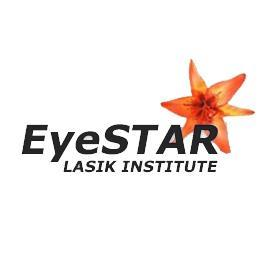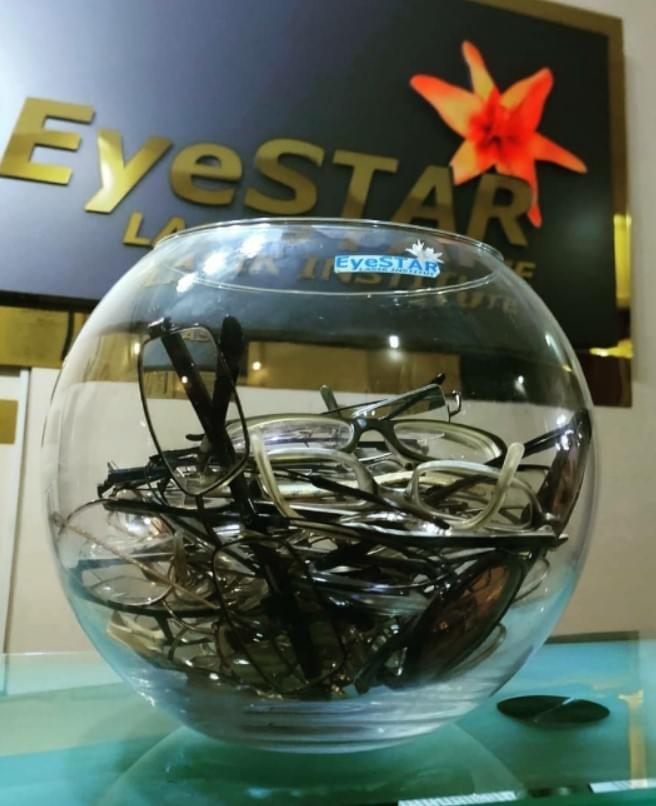


EyeSTAR L A S E K
What is LASEK?
LASEK (LASer Epithelial Keratomileusis) is a relatively new procedure that is technically a variation of PRK (Photorefractive Keratectomy). The difference is that while in PRK the epithelium is removed, it is preserved and put back in LASEK. As a result, in LASEK there is less pain and the healing is faster than PRK.
LASEK is used mostly for patients with corneas that are too thin or too flat for LASIK operation. It has been developed to reduce the incidence of complications that occur when it is anticipated that the flap created during LASIK will not have ideal thickness or diameter.


How much is L A S E K at EyeSTAR?
(LASEK and PRK are both same price)
The EyeSTAR LASEK eye laser treatment costs 1199€ for both eyes,
and it includes the following:
1. A full pre-examination and suitability tests
2. Wavefront Optimized eye laser surgery for both eyes
3. Necessary eye drops
4. Unlimited post-treatment examinations
5. EyeSTAR Lifetime Care Guarantee
6. Transfer from/to the Istanbul Airport
Before LASEK
Before your EyeSTAR LASEK eye treatment you will have a detailed eye exam. We are going to put dilating drops into your eyes and examine your retina thoroughly. You need to remove your soft contact lenses at least 1 day (ideally 1 week) before the exam and laser treatment. For hard and gas permeable contact lenses, this period is 3 weeks.
On the day of laser treatment, please do not wear any make-up (eye and face), cream, moisturizer, perfume or after-shave lotion. Do not drink too many caffeinated drinks. Since the laser room is cold, wear warm comfortable clothes. If you are going to have your laser treatment during the day, bring non-prescription sunglasses.
Before the LASEK operation you will be thoroughly informed about the procedure. We will describe how each step will feel and what you should be doing. After the mental preparation and paperwork are done, the medical preparation will start.
Before the LASEK treatment, your eyes will be numbed with drops and the area around your eyes will be wiped with a disinfectant solution. After you relax from your time in the massage chair, we will invite you to the laser room. You will be assisted to lay down on the laser bed, and the laser bed will automatically move towards the eye tracker and the laser. More drops may be placed in your eyes, and an adhesive clear drape will be placed over your eyes to protect your eyes from the non-sterility of your eyelashes and eyebrows.
LASEK Procedure Steps
These are the steps of the LASEK procedure:
1- In LASEK, the epithelium, or outer layer of the cornea, is dented like the letter C with a fine blade called a trephine.
2- The surgeon then covers the eye with an alcohol solution for approximately 30 seconds. The solution loosens the edges of the epithelium. It separates the epithelium from the underlying stroma layer.
3- After sponging the alcohol solution from the eye, the surgeon uses a tiny hoe to lift the edge of the epithelial flap,
4- and gently fold it back out of the way.
5- The surgeon then uses an excimer laser, as in LASIK or PRK, to sculpt the corneal tissue underneath.6- Afterward, the epithelial flap is placed back on the eye with a kind of spatula.
7- Just like other forms of laser treatments, the cornea gains a new shape for ideal focusing.
In many ways, what you can expect from LASEK is similar to what you can expect from PRK. Patients usually wear a bandage contact lens for around four days. You may feel eye irritation during the first day or two afterward. Also, the time it takes to recover good vision is often longer - up to four to seven days although this varies from one person to the other.
EyeSTAR LASEK results are much like our LASIK results:According to a study by the University of Illinois, Chicago, LASIK and LASEK results are about equal. The findings were published in the American Journal of Opthalmology in December 2006. To find out which procedure was better, researchers compared 122 eyes treated with LASIK to 122 eyest reated with LASEK." Both procedures seem safe, effective and predictable," researcher Dimitri Azar said. Eyes treated with LASEK had slightly better vision, but Azar said the difference was too small for patients to notice.

LASIK vs. LASEK
The most important difference between LASIK and LASEK is healing time. Some EyeSTAR LASIK patients can see up to 150% as early as the day after treatment. LASEK patients, on the other hand, see blurry for a few days, while the epithelium heals, which takes about 3 days. The "wow" from LASEK patients is gradual, not immediate as in LASIK patients. While many patients drive and go to work after having undergone the LASIK procedure, this is not the case for LASEK, as it takes a few days for the epithelium to heal. This is why it is important to arrange work schedules, babysitters, and travel arrangements accordingly.

Those who may not be eligible to have LASEK are patients:
- with uncontrolled vascular disease
- with autoimmune disease
- who are immune-compromised or on drugs and/or therapy which suppress the immune system
- with signs of keratoconus (excessive steeping of the cornea)
- possibly with a previous history of keloid formation
- who are pregnant or nursing
- with residual, recurrent, or active ocular disease(s) or abnormality except for myopia, hyperopia or astigmatism in either eye
- with active or residual disease(s) likely to affect wound healing capability
- with severe nearsightedness, farsightedness or astigmatism that is outside the limits approved by the Food and Drug Administration (FDA)
- with unstable or uncontrolled diabetes
- with progressive myopia or hyperopia
- with uncontrolled glaucoma
LASEK Risks
Laser Assisted Subepithelial Keratectomy (LASEK) risks:
LASEK is generally accepted as one of the safest laser vision correction treatment modality. The risks related to LASEK surgery is listed below. Please bear in mind that these complications are rare and most of them has never happened at EyeSTAR:
Complications that may occur during surgery:
Epithelial flap can be thorn. In this case this flap can be disposed. Therefore the LASEK treatment turns to a PRK treatment. That means the recovery time and discomfort may increase.
Complications that may be seen after surgery:
- Loss of Vision: LASEK surgery can possibly cause loss of vision or loss of best-corrected vision. This can be due to infection (internal or external), corneal irregularity or scarring, and may require additional treatment, either medical or surgical. These complications are extremely rare, but have been reported in China, Hungary, Romania, Taiwan and India.
- Visual Side-Effects: Other conditions that can occur with LASEK surgery include: anisometropia (difference in power between the two eyes); aniseikonia (difference in imaging size between the two eyes); fluctuating vision during the day, and from day to day; increased or decreased sensitivity to light that may be incapacitating for some time, and may not completely go away; glare and halos around lights which may not completely go away. With new generation lasers like the ones we use at EyeSTAR and a careful screening this is not a problem we encounter.
- Haze may be seen especially in high diopter treatments especially 6 Diopters and more. Mitomycin use may expand the safe treatment zone to higher diopters.
- Allergic reactions may be seen to anesthetic drops, Alcohol or salted distilled water use, in this case eyelids may swell, redness and some discomfort may occur for a few days.
- Other Risks: Other reported rare complications include: corneal ulcer formation; ptosis (droopy eyelid);corneal swelling; contact lens intolerance. Complications could also arise requiring further corrective procedures including either a partial (lamellar) or full thickness corneal transplant using donor cornea.
- It is also possible that the excimer laser could malfunction and stop the procedure. Since it is impossible to state all potential risks of any surgery or procedure, this list does not provide a comprehensive listing of every conceivable problem.
- Later-discovered complications: You should be aware that other complications may occur that have not yet been reported. Even though this treatment is known for about 8-9 years, longer term results may reveal additional risks and complications.
Other problems which are not classified as a complication but may require further attention are over-correction or under-correction: It may be that LASEK surgery will not give you the result you desired. Some procedures result in the eye being under-corrected. If this occurs, it may be possible to have additional surgery to improve the initial result. It is also possible that your eye may be overcorrected to the point of becoming farsighted (by over-treating myopia) or nearsighted (by over-treating hyperopia). It is possible that your initial results could regress over time. In a very few cases, re-treatment, glasses, or contact lenses might be needed in correcting vision.
EyeSTAR LASIK
PRK
What is PRK?
PRK (Photorefractive Keratectomy) means removing (shaping) corneal tissue by light (laser) in order to achieve the desired refractive correction. PRK is the first laser vision correction treatment offered to spectacle/contact lens-dependent people. Newer patient-friendly laser techniques such as LASIK and LASEK pushed PRK to third place in the eyes of refractive surgeons.
What are the advantages of PRK?
One of the advantages of the PRK method is that it is an easy surgical procedure. Even a novice eye surgeon can accomplish a PRK operation after watching a few videotapes. But precise programming of the Excimer Laser for the desired vision requires years of experience, since every doctor's surgical method and the environmental factors require construction of special nomograms for specific prescriptions and age. Another advantage of PRK is its being a quick, painless and bloodless laser procedure. PRK consumes lesser corneal tissue than LASIK. PRK or LASEK become the obvious choice when corneal thickness is critical (=thin cornea).
What are the disadvantages of PRK?
One disadvantage of PRK is its slow and painful recovery period. Even though many special techniques, such as bandage contact lenses have been developed for relieving the after-operation pain, still some discomfort should be expected for 2 to 5 days. Also the vision is blurry during this period. This may delay PRK patients' resuming "the normal life" which is the very next day for LASIK patients. Since PRK is a technique that harms the epithelium of the cornea, a clear vision should be expected after the total regeneration of the epithelium (2 to 15 days). Also achieving the final visual result may take up to six months and the recovery modulating drops (such as steroids) should be instilled during this time under the surveillance of regular doctor visits. Two more unwanted effects of PRK should be mentioned. These are especially valid for the treatment of high diopters and in case of neglecting some preventive measures:
1. Persistent foggy vision: haze.
2. Regression: After having a normal vision for a while, a portion of the old refractive error may come back.
When do we prefer PRK?
- If there is opacity (scarring) or a specific disease at the cornea besides a refractive error, a dual-purpose laser therapy (PRK) may be performed.
- If the anatomy of the eye does not allow placing a microkeratome safely on the eye, then we may choose PRK instead of LASIK.
- If the cornea is too thin for LASIK then PRK or LASEK may be the procedure of choice.
- If the patient wants to have an unnoticeable laser surgery even with the microscope during an eye exam, then we consider performing PRK or LASEK.

Contact Us:
WhatsApp: +90-212-361-5000
WhatsApp: +90-541-500-1900
Phone: +90-212-361-5000
Manager email: manager@eyestar.us
Copyright 2023



